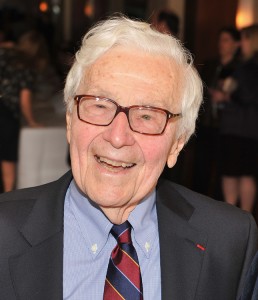John Morris: Seeing a Century
August 8, 2017
Late last month, on July 28, legendary American photographic editor John Morris died at a hospital near his home in Paris, France. A longtime editor for magazines, newspapers, and the famous Magnum Photos cooperative, Morris commissioned and published some of the most iconic photographs of the 1900’s. He was 100 years old.

John Morris attends the 2010 International Center of Photography Infinity Awards in New York City. Credit: © Theo Wargo, Getty Images
John Godfrey Morris was born on Dec. 7, 1916, in Maple Shade, New Jersey. Morris grew up in Chicago, where he attended the University of Chicago. As a student, Morris helped found and edit a university publication modeled on Life magazine—one of the era’s most popular illustrated publications.
After graduating in 1938, Morris began working for Time-Life publications in New York City. After the outbreak of World War II (1939-1945), Morris went to London, where he edited the many war photos going into Life’s weekly editions. On June 7, 1944, he edited the stirring images captured by Robert Capa the day before as the famous photographer hit the beaches of Normandy, France, with the U.S. Army on D-day. Before the invention of digital photography, photographers in the field rarely saw their developed images. It was up to a photo editor to process the photographer’s film and select, crop, and otherwise edit the photographs for publication.
After the war, Morris returned to New York City, where he worked as photo editor for the Ladies’ Home Journal, the biggest selling magazine at the time. One of his most ambitious projects there was sending Capa and author John Steinbeck to report on conditions in the Soviet Union. In 1953, Morris became executive editor of Magnum Photos, a cooperative created by Capa and others to help photographers sell their work while keeping copyright control. At the time, Magnum employed such photography stars as Capa, Eve Arnold, Henri Cartier-Bresson, Alfred Eisenstaedt, David Seymour, and W. Eugene Smith. Today, Magnum continues to be one of the world’s preeminent photographic agencies.
Morris served briefly as photo editor for The Washington Post before joining The New York Times in 1967, during the Vietnam War (1957-1975). In 1968, Morris insisted a graphic photograph of the execution of a Viet Cong prisoner run on the front page of the Times—a photograph many credit with help turning public opinion against the war. In 1972, Morris published another now-famous photo showing screaming Vietnamese children fleeing a napalm attack. Those two Vietnam War images both won the Pulitzer Prize. “I have always believed in showing how ugly war is,” Morris said, “and I have encouraged newspapers to take a realistic view of war.”
Morris later moved to Paris, where he worked for National Geographic before retiring in 1989. In his later years, Morris worked with young photographers and often spoke about his long career and of his experiences with some of the world’s greatest photographers. Oddly enough, Morris himself rarely took photos, but his editorial vision helped create and define modern photojournalism.


